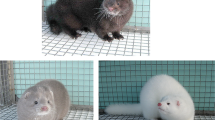Abstract
A rare color variant of the American mink (Neovison vison), discovered on a ranch in Nova Scotia and referred to as the “marbled” variety, carries a distinctive pigment distribution pattern resembling that found in some other species, e.g., the Siamese cat and the Himalayan mouse. We tested the hypothesis that the color pattern in question—light-colored body with dark-colored points (ears, face, tail, and feet)—is due to a mutation in the melanin-producing enzyme tyrosinase (TYR) that results in temperature-sensitive pigment production. Our study shows that marbled mink carry a mutation in exon 4 of the TYR gene (c.1835C > G) which results in an amino acid substitution (p.H420Q). The location of this substitution corresponds to the amino acid position that is also mutated in the TYR protein of the Himalayan mouse. Thus, the marbled variant is more aptly referred to as the Himalayan mink.



Similar content being viewed by others
References
Aigner B, Besenfelder U, Müller M, Brem G (2000) Tyrosinase gene variants in different rabbit strains. Mamm Genome 11:700–702
Altschul SF, Gish W, Miller W, Myers EW, Lipman DJ (1990) Basic local alignment search tool. J Mol Biol 215:403–410
Anistoroaei R, Fredholm M, Christensen K, Leeb T (2008) Albinism in the American mink (Neovison vison) is associated with a tyrosinase nonsense mutation. Anim Genet 39:645–648
Benkel BF, Fong Y (1996) Long range-inverse PCR (LR-IPCR): extending the useful range of inverse PCR. Genet Anal 13:123–127
Blaszczyk WM, Distler C, Dekomien G, Arning L, Hoffman K-P et al (2007) Identification of a tyrosinase (TYR) exon 4 deletion in albino ferrets (Mustela putorius furo). Anim Genet 38:421–423
Garcia-Borron JC, Solano F (2002) Molecular anatomy of tyrosinase and its related proteins: beyond the histidine-bound metal catalytic center. Pigment Cell Res 15:162–173
Giebel LB, Tripathi RK, King RA, Spritz RA (1991) A tyrosinase gene missense mutation in temperature-sensitive type I oculocutaneous albinism. A human homologue to the Siamese can and the Himalayan mouse. J Clin Invest 87:1119–1122
Hall TA (1999) BioEdit: a user-friendly biological sequence alignment editor and analysis program for Windows 95/98/NT. Nucleic Acids Symp Ser 41:95–98
Kidson SH, Fabian BC (1981) The effect of temperature on tyrosinase activity in Himalayan mouse skin. J Exp Zool 215:91–97
Kwon BS, Halaban R, Chintamaneni C (1989) Molecular basis of the mouse Himalayan mutation. Biochem Biophys Res Commun 161:252–260
Lyons LA, Imes DL, Rah HC, Grahn RA (2005) Tyrosinase mutations associated with Siamese and Burmese patterns in the domestic cat (Felis catus). Anim Genet 36:119–126
Petrij F, van Veen K, Mettler M, Bruckmann V (2001) A second acromegalistic allelomorph at the albino locus of the Mongolian gerbil (Meriones unguiculatus). J Hered 92:74–78
Schmidt-Küntzel A, Eizirik E, O’Brien SJ, Menotti-Raymond M (2005) Tyrosinase and tyrosinase-related protein 1 alleles specify domestic cat color phenotypes of the albino and brown loci. J Hered 96:289–301
Schweikardt T, Olivares C, Solano F, Jaenicke E, Garcia-Borron JC et al (2007) A three-dimensional model of mammalian tyrosinase active site accounting for loss of function mutations. Pigment Cell Res 20:394–401
Acknowledgments
The authors gratefully thank Mr. Ron Barr for providing samples of Himalayan mink, Tanya Muggeridge and Amanda Smith for technical assistance, and the Canada Research Chairs program (www.Chairs.gc.ca) for financial support.
Author information
Authors and Affiliations
Corresponding author
Rights and permissions
About this article
Cite this article
Benkel, B.F., Rouvinen-Watt, K., Farid, H. et al. Molecular characterization of the Himalayan mink. Mamm Genome 20, 256–259 (2009). https://doi.org/10.1007/s00335-009-9177-6
Received:
Accepted:
Published:
Issue Date:
DOI: https://doi.org/10.1007/s00335-009-9177-6




